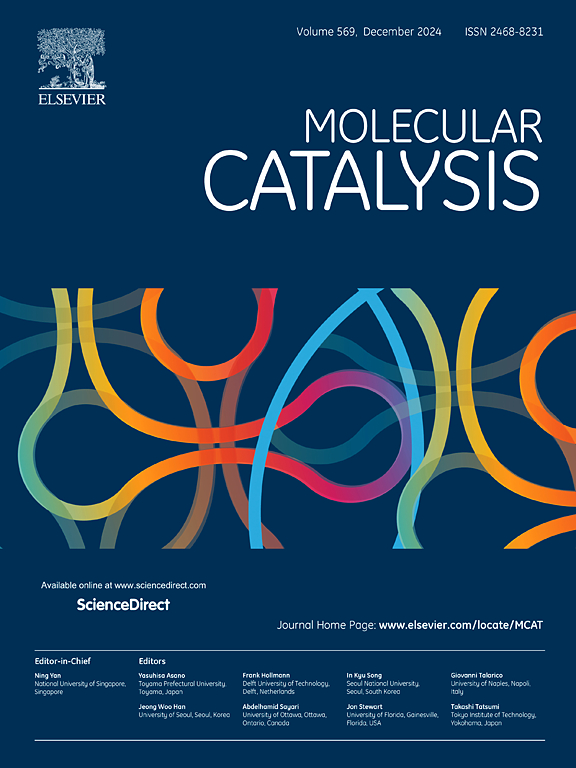1,10-phenanthroline complexes derived N-doped Pd nanoparticle encapsulated in TS-1 zeolite for acetylene dialkoxycarbonylation
IF 4.9
2区 化学
Q2 CHEMISTRY, PHYSICAL
引用次数: 0
Abstract
Achieving stable heterogeneous catalysts remains a critical challenge in acetylene dialkoxycarbonylation. This study introduces a strategy to encapsulate Pd nanoparticles within TS-1 zeolite via a ligand-protection method, followed by N doping to enhance catalyst stability. It is verified that N doping onto Pd nanoparticles could modify its nanostructure and the coordination bonds, so that the thermal stability of which was significantly enhanced and the CO adsorption capability on it was improved. Moreover, the number of Lewis acid sites (LAS) or Brønsted acid sites (BAS) could be tuned by adjusting the amount of tetrapropylammonium hydroxide (TPAOH) in the synthesis process. The increased number of acid sites enhanced the adsorption capacity of the Pd-N@TS-1(1) catalyst for acetylene, thereby mitigating the deactivation of Pd sites by C₂H₂ under CO-rich conditions. Consequently, the optimized catalyst exhibited a high dialkoxycarbonylation selectivity of 97 % with a significantly improved cycling stability over five cycles. Density Functional Theory (DFT) calculations revealed that the Pd-N site was the primary active center for CO activation, N doping reduced the adsorption energy of CO, promoted its enrichment, and increased the insertion frequency of CO, thereby enhanced the catalytic activity. This approach to controlling the catalytic behavior of Pd sites provides a promising strategy for designing efficient catalysts with long-term stability for acetylene dialkoxycarbonylation.

1,10-邻菲罗啉配合物衍生的n掺杂Pd纳米颗粒包封于TS-1沸石中用于乙炔二氧羰基化
获得稳定的非均相催化剂仍然是乙炔二氧羰基化的关键挑战。本研究介绍了一种通过配体保护方法将Pd纳米颗粒包埋在TS-1沸石中的策略,然后通过N掺杂来提高催化剂的稳定性。验证了在Pd纳米粒子上掺杂N可以改变其纳米结构和配位键,从而显著增强了Pd纳米粒子的热稳定性,提高了其对CO的吸附能力。此外,合成过程中可以通过调节四丙基氢氧化铵(TPAOH)的用量来调节Lewis酸位点(LAS)或Brønsted酸位点(BAS)的数量。酸位数量的增加增强了Pd-N@TS-1(1)催化剂对乙炔的吸附能力,从而减轻了co -富条件下C₂H₂对Pd位的失活。结果表明,优化后的催化剂具有97%的二氧羰基化选择性,并在5个循环中显著提高了循环稳定性。密度泛函理论(DFT)计算表明,Pd-N位点是CO活化的主要活性中心,N掺杂降低了CO的吸附能,促进了CO的富集,增加了CO的插入频率,从而提高了催化活性。这种控制Pd位点催化行为的方法为设计长期稳定的乙炔二氧羰基化催化剂提供了一种有前途的策略。
本文章由计算机程序翻译,如有差异,请以英文原文为准。
求助全文
约1分钟内获得全文
求助全文
来源期刊

Molecular Catalysis
Chemical Engineering-Process Chemistry and Technology
CiteScore
6.90
自引率
10.90%
发文量
700
审稿时长
40 days
期刊介绍:
Molecular Catalysis publishes full papers that are original, rigorous, and scholarly contributions examining the molecular and atomic aspects of catalytic activation and reaction mechanisms. The fields covered are:
Heterogeneous catalysis including immobilized molecular catalysts
Homogeneous catalysis including organocatalysis, organometallic catalysis and biocatalysis
Photo- and electrochemistry
Theoretical aspects of catalysis analyzed by computational methods
 求助内容:
求助内容: 应助结果提醒方式:
应助结果提醒方式:


